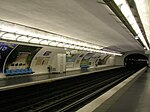Buzenval (Paris Métro)
Paris Métro line 9Paris Métro stations in the 20th arrondissement of ParisParis Métro stubsRailway stations in France opened in 1933

Buzenval (French pronunciation: [byzɑ̃val]) is a station on line 9 of the Paris Métro, on the Rue de Buzenval in the 20th arrondissement. The station was opened on 10 December 1933 with the extension of the line from Richelieu - Drouot to Porte de Montreuil. The street is named after the commune of Buzenval, which is another name for Rueil-Malmaison. This is where the Battle of Buzenval of the Siege of Paris, part of the Franco-Prussian War took place on 19 January 1871. The "Tarzan" of "Buzenval" was the nickname of Laurent Dauthuille, a boxer of the 1950s.
Excerpt from the Wikipedia article Buzenval (Paris Métro) (License: CC BY-SA 3.0, Authors, Images).Buzenval (Paris Métro)
Rue d'Avron, Paris Quartier de Charonne (Paris)
Geographical coordinates (GPS) Address Nearby Places Show on map
Geographical coordinates (GPS)
| Latitude | Longitude |
|---|---|
| N 48.851976 ° | E 2.402045 ° |
Address
Carrefour Market
Rue d'Avron
75020 Paris, Quartier de Charonne (Paris)
Ile-de-France, France
Open on Google Maps









